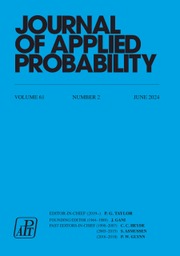No CrossRef data available.
Article contents
Coupling results and Markovian structures for number representations of continuous random variables
Published online by Cambridge University Press: 28 April 2025
Abstract
Consider nested subdivisions of a bounded real set into intervals defining the digits  $X_1,X_2,\ldots$ of a random variable X with a probability density function f. If f is almost everywhere lower semi-continuous, there is a non-negative integer-valued random variable N such that the distribution of
$X_1,X_2,\ldots$ of a random variable X with a probability density function f. If f is almost everywhere lower semi-continuous, there is a non-negative integer-valued random variable N such that the distribution of  $R=(X_{N+1},X_{N+2},\ldots)$ conditioned on
$R=(X_{N+1},X_{N+2},\ldots)$ conditioned on  $S=(X_1,\ldots,X_N)$ does not depend on f. If also the lengths of the intervals exhibit a Markovian structure,
$S=(X_1,\ldots,X_N)$ does not depend on f. If also the lengths of the intervals exhibit a Markovian structure,  $R\mid S$ becomes a Markov chain of a certain order
$R\mid S$ becomes a Markov chain of a certain order  $s\ge0$. If
$s\ge0$. If  $s=0$ then
$s=0$ then  $X_{N+1},X_{N+2},\ldots$ are independent and identically distributed with a known distribution. When
$X_{N+1},X_{N+2},\ldots$ are independent and identically distributed with a known distribution. When  $s>0$ and the Markov chain is uniformly geometric ergodic, there is a random time M such that the chain after time
$s>0$ and the Markov chain is uniformly geometric ergodic, there is a random time M such that the chain after time  $\max\{N,s\}+M-s$ is stationary and M follows a simple known distribution.
$\max\{N,s\}+M-s$ is stationary and M follows a simple known distribution.
Keywords
MSC classification
Information
- Type
- Original Article
- Information
- Copyright
- © The Author(s), 2025. Published by Cambridge University Press on behalf of Applied Probability Trust


